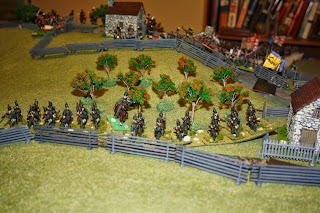The American view looking NNW with the most of the Yankee guns placed on the Queenston Road. Porters' Brigade is deploying west of the road to face the British 1st Brigade coming in from the Burlington Road area.
On the American right flank. What is left of Scott's First Brigade is still engaged with the 1st Royal Scots and the 89th regiments. The doodles are still taking casualties but are no inflicting significant casualties on the British. Ripley's Second Brigade to left of Scott's is inflicting heavy damage on the British by neutralizing both the rocket battery and the big 24pdr. Most of the British casualties were caused by the supporting fire of the aforementioned U.S. guns.
An overall view looking west over the woods with American guns on the left, next right Ripley's Brigade and then Scott's.
A view looking NNE with Porters' Third Brigade on the right deploying onto to open field. In center middle is Glengarry Light Infantry at the ready in the orchard against the rail fence. To the right of the GLI is the Incorporated Militia of Upper Canada. In the left foreground, LCol Scott is scouting ahead of the 1st Brigade. It seems likely that an engagement will soon take place on this field.
Scott's 1st Brigade getting underway after a major cavalry engagement manged slowed its movement eastbound. Yours truly was remiss by not getting some photos of the cavalry engagements, particularly as it was the first one in our War of 1812 games series. Nevertheless, a statement will have to make do.
The New York Volunteer Dragoons managed to occupy the attention of the 19th L.D.s while the regular L.D.s unexpectedly charged the 103rd Foot, which was in column. The U.S. L.D.s passed their charge home test and the 103rd passed its formation change test ( to square). Fortunately for the 103rd, the L.D.s were at near max charge distance, which meant that it when it was moved to the charge half way point it was slightly over half its charge distance. This meant that the 103rd had time to form square. It was a matter of an inch or so. This meant that the instead of the L/D.s attacking a vulnerable 103rd in column it had to attack a formed square. The results were devastating; the L.D.s were destroyed in a combination of defensive fire and ensuing melee.
In the other cavalry engagement; the NYVDs retired having successfully diverted the 19th LDs attention away from the regulars. However, in the next turn the 19th caught up with them and inflicted a casualty...they got off lightly. However, the NYLDs were routed and in the subsequent turn dispersed.
All in all it was a brilliant tactical move by the American cavalry that was robbed of a qualified success by a matter of an inch. However, the American attack slowed down the British advance by at least three turns, which could proved significant.
The congestion in the center of British lines on the LL summit is somewhat relieved after the routing of the rocket battery and the 24pdr crews plus the movement forward of the GLI and militia.
A close up of the 1st Royal Scots in action.
A close up opposite the 1st Foot is the Twenty-Second Infantry of Scott's Brigade.
A close up of the GLI in the orchard, with a mounted LCol Battersby giving encouragement.
A scene of heavy fighting in front of the British guns. The rocket battery and 24pdr are abandoned in the face of American artillery fire combined with Ripley's attack led by the Twenty-third Infantry. To the left of the British guns the composite 1st Militia unit (Bde), which has recently moved into position. To the left are the remaining British guns a howitzer and a 6pdr.
It seems the battle of Lundy's Lane is reaching a culminating point. When the fourth session commences the time will be 2230 with darkness at 2250. Darkness will reduce the visibility to 12 inches coupled with the possibility of friendly fire and getting lost.











No comments:
Post a Comment